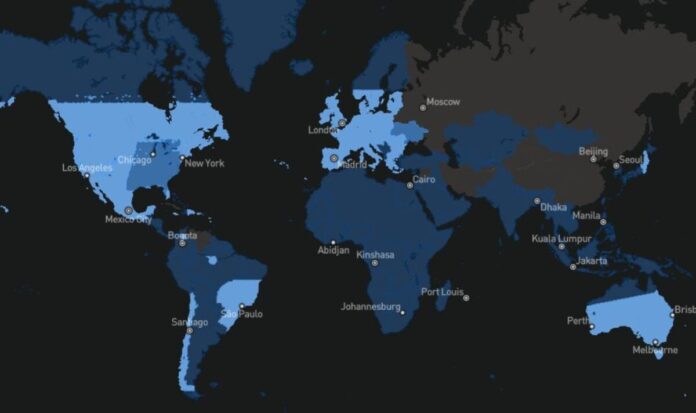Coverage afforded by Elon Musk’s Starlink satellite Internet is expanding on a nearly month-by-month basis, with next year expected to see the service area essentially double. According to SpaceX’s interactive coverage map, nations set to gain access to the globe-spanning wireless internet system in 2023 include Finland, Kenya, and Papua New Guinea. This year has seen the service expand to such locations as Brazil, Hungary, and Moldova – as well as more notably both Ukraine and Iran in response, respectively, to the Russian invasion and censorship following protests against rules making the hijab compulsory. However, many areas of the world remain off-grid as far as Starlink is concerned – with key examples being Russia, China and Venezuela. In other countries, delays in arrival are down to the fact that regulatory approval is still pending. as in the cases of India, Pakistan and Thailand. Starlink has been available in the UK since January last year.While satellite internet technology has been around for many years, SpaceX was the first firm to really make the concept commercially viable, overcoming the both connectivity and latency issues that had beset their predecessors.They have set a trend now followed by various competitors, including OneWeb, ViaSat, and – to launch next year – Amazon’s Project Kuiper.Mr Musk has previously said that he hopes Starlink will bring internet access to some three billion people who previously were unable to get online cheaply and easily.However, the launch of large satellite constellations into orbit – SpaceX, for example, presently has more than 3,100 in orbit – has attracted the criticism of the scientific community, who note that the craft increase light pollution and generate other forms of interference that inhibits astronomical observations. Coverage afforded by Elon Musk’s Starlink satellite Internet is expanding on a nearly monthly basis (Image: SpaceX) Pictured: a Starlink satellite dish in Odesa, Ukraine (Image: Getty Images)Yesterday, SpaceX announced that it will soon be bringing the ability to connect to the Starlink Internet service from moving vehicles.The firm tweeted: ‘Enjoy high-speed, low-latency Internet while on the move! Now accepting orders for the flat high-performance Starlkink, which provides connectivity while in motion on land.’Mr Musk added: ‘Works on any moving land object.’The new hardware – which is expected to roll out in December – builds on the ‘Starlink for RVs’ (recreational vehicles) service SpaceX launched back in May this year.The previous offering, which used a standard £460 satellite dish, is designed to operate only while stationary. In contrast, the new flat high-performance dish is reported to cost a whopping $2,500 (£2,164) – with the monthly service charge of £95 on top of that.READ MORE: Musk vows to continue helping Ukraine following Starlink speculation SpaceX presently has more than 3,100 Starlink satellites in orbit (Image: Express.co.uk) SpaceX will soon be bringing the ability to connect to the Starlink service from moving vehicles (Image: SpaceX)SpaceX said: ‘Starlink for RVs is ideal for customers travelling to locations where connectivity has been unreliable or completely unavailable.’With a wide field of view and enhanced GPS capabilities, the Flat High Performance Starlink can connect to more satellites, allowing for consistent connectivity on the go.’The hardware is designed for a permanent installation on your vehicle and is resilient in harsh environments.’Both the Standard and Flat High Performance Starlink require a clear view of the sky to connect.’DON’T MISS:Major cable cut in France just hours after Shetland incident [REPORT]British Gas unveils ‘essential’ heat pump lifeline to help slash £8000 [INSIGHT]UK facing energy crisis horror as millions of Britons trapped in debt [ANALYSIS] Saturday saw SpaceX rival OneWeb launch a 36 satellites into orbit on an Indian rocket (Image: OneWeb)Elsewhere in the space-based Internet industry, last Saturday saw SpaceX rival OneWeb launch a 36-strong satellite constellation into orbit using, for the first time, an Indian rocket – the firm having previously used Roscosmos’ Soyuz rockets prior to Russia’s invasion of Ukraine.The mission blasted off from the Satish Dhawan Space Centre in Sriharikota onboard an Indian Space Research Organization (ISRO)’s GSLV Mark III rocket – the first commercial payload for the 143-feet-tall space vehicle.OneWeb tweeted: ‘A huge thanks to the teams at ISRO and NewSpace India Limited for a successful lift off!’The deployment brings the firm’s total complement of satellites up to 462 – with the firm planning to place another 186 satellites in orbit, via five launches, by the middle of next year.In a statement, OneWeb executive chairman Sunil Bharti Mittal called the recent launch a ‘significant milestone’,He added: ‘This new phase of our launch program from India brings us a step closer to not only enhancing our global coverage but also delivering connectivity in India and South Asia, particularly to the communities who need it most.’
29 August, Thursday, 2024


